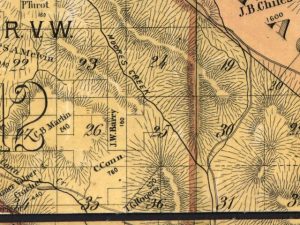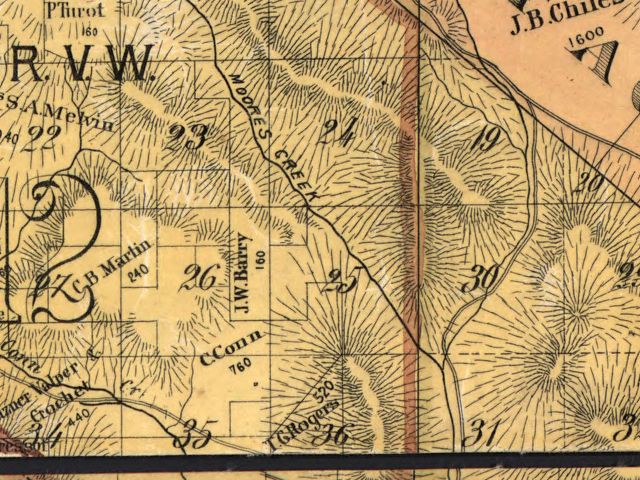Napa County, People
The Moore Family of Moore’s Creek
by Marie Bowen

Moore Creek runs southerly year-round from its source high on the eastern side of Howell Mountain, and joins with Conn Creek before emptying into Lake Hennessey at what is now Moore Creek Park. On the way it passes through Las Posadas State Forest, land once owned by the John Milton Morris family. Before the Morris family, the forest, and the park, Moore Creek was known as “Moore’s Creek,” identified as such on both the 1876 and 1895 Official Maps of Napa County. So, just who was Moore?
Sources state the creek was named for or by the Moore family from Ireland, considered the first white settlers in that area. First names are never mentioned – they were unknown or forgotten. Said to be squatters, the family may have lived on Howell Mountain possibly as far back as the 1840s, about the time John Howell settled there in 1847.
The six-page 1850 Nappa Valley census shows no Moore or More family. However, the 1860 Hot Springs census lists one Moore family: William G. Moore, born 1815 in Londonderry, Ireland; his wife Bridget, born 1824 in Ireland; and three children, all born in California between 1854 and 1857. (A fourth child – a third son – was born in 1861.) Also on the 1860 census is Conley Conn, whose property lay southwest of Moore’s Creek. William is the only head of household on that census page whose occupation is shepherd. A second 1860 census (non-population agricultural) lists him as the owner of one cow and five “other cattle.” Thirteen heads of household on that one census page owned a total of almost 8,000 sheep so, presumably, William kept busy. And, most importantly, he owned no real estate. He was squatting.
With the Federal Land Act of 1851, squatters’ rights could be guaranteed if the claims of Mexican land grant recipients were not proved – as long as the land claimed by the squatter did not exceed 160 acres. It is thought that the largest number of squatters lived on George Yount’s two massive land grants, one of them, Rancho La Jota, included Howell Mountain. Several sources state that a Mr. Musso acquired the Moore squatters’ rights, selling them later for $1,000 and a cow to John Morris. Neither of these transactions is of record, which was typical of the way squatters’ rights were handled, but there is one recorded transaction involving William G. Moore in Napa County. On February 10, 1864, he sold to W. W. Stillwagon a 160-acre parcel along the eastern line of Rancho La Jota for $500. Since William never acquired any Napa County land of record, perhaps Dr. Stillwagon, a local physician, may have been a straw man, receiving and passing squatters’ rights on to Mr. Musso – but not of record.

Edith Gregory’s 1938 Pioneers of Las Posadas references the (undated) death of the Ireland-born “Mrs. Moore” on Howell Mountain. Napa County deaths were not recorded until 1873, so I may never know if the deceased Mrs. Moore was Bridget Moore. St. Helena Public Cemetery records show no Moore burial before 1865. But in that year, a William G. Moore married a Miss A. Sunney in Napa County – possibly the widowed William, no longer on Howell Mountain. 1867-1870 records find the family near Sebastopol in Sonoma County, this time with real estate valued at $400. One of the records reveals William’s middle name: Gordon. Once again, he is unmarried. In 1873, his three sons, all younger than 18, live together in Washington state. Perhaps William is dead? The youngest son died in 1897 and no identifiable records were found for his two brothers after 1880. Their sister vanishes, as does William, by 1870.
There is no smoking gun to prove that this was the family of Moore’s Creek, but it seems credible. They were the only Moore family in the area. Bridget’s disappearance before 1865 seems to correspond to Mrs. Moore’s death mentioned by Edith Gregory. And the land conveyed by William in 1864 lies within the Howell Mountain area. It troubles me that no first names were remembered for this family. Surely they were not discriminated against because they were squatters. Was it because they were Irish? For whatever reason, they seem to have been forgotten…but not their creek.
Reference List
Clay, Karen Clay and Werner Troesken. ‘Squatting and the Settlement of the U.S.’ Advances in Agricultural Economic History, Vol. 1, pp 207-233. JAI press, Inc., 2000
Cronk, Duane L. ‘The Morris Family Ranch.’ The Angwin Reporter, June 29, 2012 (online)
Dillon, Richard H. NAPA VALLEY HEYDAY. San Francisco: Book Club of California, 2004
Gregory, Edith. ‘Pioneers of Las Posadas.’ Unpublished, 1938 (as found in OLD NAPA VALLEY…)
Lewis Publishing Company. A MEMORIAL AND BIOGRAPHICAL HISTORY OF NORTHERN CALIFORNIA. Chicago, Lewis Publ. Co., 1891
Menefee, C. A. HISTORICAL AND DESCRIPTIVE SKETCH BOOK OF NAPA, SONOMA, LAKE, AND MENDOCINO. Napa, Reporter Publishing House, 1873.
Napa County Book A of Marriages, Page 162
Napa County Book DH of Deeds, Page 325; Instrument #1002-0008325, February 10, 1864
Weber, Lin. OLD NAPA VALLEY. St. Helena, Wine Ventures Publishing, 1998
Wichels, John. Oral history tapes 209 and G


